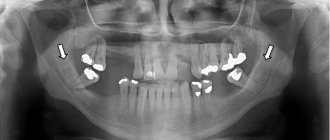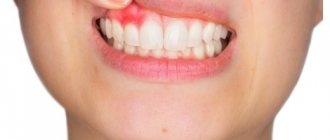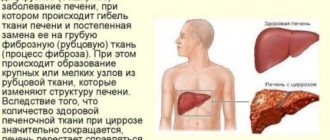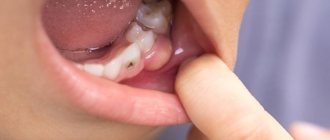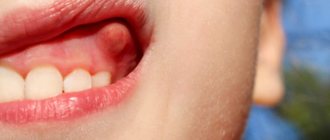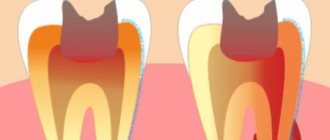From this article you will learn:
- what is a cyst on the gum - photos, symptoms,
- what it looks like in a child.
- how to treat a cyst on the gum.
The article was written by a dental surgeon with more than 19 years of experience.
A cyst on the gum is an inflammatory formation filled with pus that forms on the gum in the projection of the source of inflammation at the root of the tooth. In other words, in appearance such a cyst resembles a purulent sac on the gum, and it looks the same in both children and adults (Fig. 1-3). It should be noted that in dentistry such a term does not exist, and therefore the expression “cyst on the gum” is nothing more than an everyday colloquial expression.
As you already understand, such a purulent sac forms on the gum only if there is inflammation at the root of the tooth, which in dentistry is referred to as apical periodontitis. The formation of a cyst always occurs in the projection of the root of the causative tooth, and on the tooth itself you can always see either caries, a filling or a crown. Well, in children it can also form as a result of a tooth injury (due to an impact or a fall), in which case a chip may be found on the tooth, or the crown part of the tooth will be painted bluish.
Cyst on the gum: photo
In photo 1 you can see a cyst filled with pus, which formed in the projection of the roots of the destroyed 6th lower tooth. What does a cyst on a child’s gum look like – photos 2-3 (and in these photographs we see that in one case the causative tooth has a carious lesion, and in the other there is a traumatic fracture of the crown). Depending on whether it is a baby tooth or a permanent one, on the amount of destruction of the tooth crown and on the size of the inflammatory focus, both conservative therapy for dental periodontitis and tooth extraction can be carried out.
The latter especially concerns children, because approach to the treatment of baby teeth with inflammatory foci in the root area (especially in the presence of a fistula or purulent sac on the gum) absolutely does not involve saving the tooth. This is due to 1) the peculiarity of the structure of the root canals in baby teeth, 2) the risk of death of the rudiments of permanent teeth (the latter are almost closely adjacent to the roots of baby teeth). Read more about this at the link below.
→ Treatment of an abscess on the gum of a child
How does a tooth root cyst appear?
The causes of cysts are varied, and among them it is impossible to single out the prevailing ones. So, this may be the result of physical trauma to the maxillofacial bones, or a rare but common medical error, in which the tightness of the root canal was broken, which became the basis for the emergence of a source of infection. A similar situation occurs when a dental crown is installed incorrectly. But the reasons for cyst formation are not limited to this. Untreated infectious diseases (in particular, sinusitis or periodontitis) are no less a provoking factor.
Why does it occur
Among the main causes of pathology:
- advanced caries;
- jaw injuries;
- illiterate root canal treatment;
- overload of individual units as a result of poorly performed prosthetics;
- congenital anomalies of the upper/lower jaw;
- infections of the nasopharynx and oral cavity.
Regardless of the characteristics of the provoking factor, a gum cyst should be treated under the supervision of a dentist. Self-medication for this diagnosis is unacceptable.
Classification of dental cysts
There are not many types of cysts, so understanding them is not difficult. Four main types are distinguished by location:
- wisdom tooth cyst;
— a cyst due to an illiterate (unprofessional) installed dental crown;
- a cyst that arose as a result of the influence of a third-party infectious disease (sinusitis);
- a cyst localized in the area of the front teeth.
At the same time, a classification is used based on previous circumstances preceding the occurrence of the cyst:
- a disease caused by poor-quality removal of one or more teeth;
— periodontal type cyst, provoked by an inflammatory process in the gums;
- a cyst caused by the growth of a wisdom tooth (retromolar or paradental);
- a cyst that occurs in children, first during the period of the appearance of milk (follicular) teeth, and then molars (eruption cyst);
— a cyst that arose as a complication of periodontitis (radicular);
— a situation is also possible in which the tissue forming the tooth degenerates (keratocyst).
Content
- How does a dental cyst form?
- Symptoms
- Types of cysts
- Is it possible to cure a cyst?
A cyst is the most common pathology of all possible dental formations. It is a kind of benign tumor that consists of mature cells. Such a nuisance can occur for a number of reasons on healthy and damaged teeth. Cysts must be removed. Often the cyst can be treated or removed while saving the tooth. In some cases, the tooth cannot be saved and must be removed along with the formation.
PROMOTION
Dental restoration, installation of fillings
from 2200 rub.
Diagnosis of symptoms of tooth root cyst
The appearance of a cyst implies the formation of a cavity, which gradually grows while simultaneously filling with pus. This condition can last for a long time, and the patient does not experience pain. A sign suggesting the presence of a cyst is slight pain that occurs when pressing on the gum. Such a symptom only in rare cases becomes a reason to visit a dentist. Basically, it occurs in later stages, when the pain intensifies and becomes nagging, continuous, cannot be relieved with analgesics, and inflammation begins to additionally manifest itself in the form of swelling and swelling of the gums in combination with a persistent unpleasant odor in the oral cavity. Finally, a situation cannot be ruled out in which a fistula occurs - that is, a channel through which the contents of the cavity independently come out.
An effective way to detect a cyst in a timely manner is to conduct an X-ray examination followed by its opening and removal.
It should be noted that at the very beginning the disease poses minimal danger to surrounding tissues, since the cavity itself is reliably isolated by thick walls. However, as pus accumulates, the pressure on the walls increases, creating the possibility of a breakthrough, which can lead to blood poisoning and, in the long term, damage to the structure of the jaw bones. At the same time, the dynamics of cyst development are unpredictable and strictly individual. However, in the presence of other inflammatory processes or infections, in a weakened body the transition to the acute stage can occur quickly.
Particular attention should be paid to early diagnosis of the disease in pregnant women. This is due to the complexity of treatment: during pregnancy, only stabilization of the cyst is possible. If the inflammatory process worsens, the choice of treatment methods is strictly limited. That is why, at the planning stage of pregnancy, it is necessary to undergo a full examination by a dentist.
How to help a child at home with suppuration?
If suppuration and the formation of a lump on the gum appear, it is recommended to contact a dentist as soon as possible, but, unfortunately, for various reasons this is not always possible.
If an adult can endure pain (although, of course, situations are different), then it is much more difficult for a child to endure painful sensations, and it is not easy for parents to watch their child suffer. There are ways to alleviate the baby's condition. Naturally, they will not replace full-fledged treatment, so you can resort to them only in situations where going to the doctor is impossible right now.
These include:
- take as much warm liquid as possible, which reduces intoxication of the body;
- eat liquid food (moderately warm, but not hot!), as it injures already damaged gums;
- If the pain becomes severe, you can use painkillers. For example, Nurofen or Paracetamol - the exact dosage depends on the age of the child, so before use you should carefully read the instructions for the drug;
- to reduce swelling, you can resort to cold - any frozen product from the freezer compartment of the refrigerator is wrapped in a soft cloth and applied to the cheek;
- use rinsing solutions that temporarily relieve pain - chamomile decoction or the drug chlorhexidine, which reduces irritation.
Tooth root cyst in children
The disease has features and varieties that are characteristic strictly for children. First of all, we are talking about formations that arise and go away on their own, without complications: in the form of a rash that appears on the gums, as well as the so-called “Epstein’s pearl”. Both varieties do not pose a danger due to the absence of purulent masses, which means that the cavity is infected. In addition, they may not occur at all, being only some of the phenomena accompanying the development of the child.
The situation is different with the appearance of a cyst during the growth of teeth (both milk and molars). In this case, the resulting cavities are infected, and given the previously described asymptomatic nature of the disease in the early stages, the most reliable method of determining its presence is regular visits to the doctor. This allows for successful treatment at the very beginning of the development of the cyst, saving the tooth in almost 100 percent of cases.
Methods for treating dental cysts
As mentioned earlier, the only reliable and error-free method for diagnosing a cyst on the root of a tooth is an x-ray. In most cases, one x-ray is sufficient; however, due to individual tooth growth patterns, an additional x-ray of the root portion may be required.
Based on the analysis of X-ray data, the dentist determines and prescribes the type of treatment. Due to the difficulty of accessing the cavity, the process of getting rid of the cyst can take several sessions - however, only this method allows you to eliminate the pathology while keeping the tooth itself healthy.
There are two main directions of treatment: therapeutic and surgical.
— the sequence of actions during therapeutic treatment is as follows: the dentist gains access to the intradental canals (to do this, the tooth tissue is opened), expands them, cleans the cavity from pus, then disinfects it and installs a temporary filling. In the absence of relapse and a favorable outcome, the temporary filling is replaced with a permanent one. An alternative option may be the depophoresis method. Its difference is that the cleaning of the canals occurs due to the sequential introduction of a special substance into them, which, under the influence of an electric current, disinfects them. The common property of both methods is their applicability in the early stages of the disease;
— surgical intervention is used in most cases due to its reliability and high efficiency. There are three types of surgical treatment: cystectomy, hemisection and cystotomy. The first option involves opening the gum from the side and removing the cyst, followed by suturing. Rehabilitation takes place while taking antibiotics. Hemisection requires additional removal of the affected tooth root and crown fragment. If a cystotomy is prescribed, penetration into the cavity is carried out through the near wall. This method has a significant rehabilitation period.
In addition to the above methods, laser therapy is used. Its principle of operation is to insert a thin tube into the cyst, allowing complete disinfection using a laser, followed by vacuum cleaning. This progressive method is painless and effective, since it is guaranteed to preserve the tooth and protect against recurrence of pathology.
Rehabilitation period and prevention of dental cysts
Due to the fact that the cyst is an inflammatory infectious process, drug therapy necessarily includes taking antibiotics, which are selected by the attending physician. Vitamin complexes and immunomodulators act as compensating medications. Treatment of dental cysts with medications is carried out simultaneously with removal of the cyst.
The main ways to avoid the disease are to regularly visit the dentist and carefully monitor oral hygiene. For preventive purposes, you can periodically rinse with infusions and decoctions - for example, aloe, calendula, sage. Combined with strict adherence to the dentist’s recommendations and timely relief from chronic nasopharyngeal diseases, this will ensure dental health for years to come.
You also need to clearly understand that a cyst on the root of a tooth is one of the serious and complex diseases, the treatment of which requires time and highly qualified surgeons. Only this guarantees the absence of complications: re-infection, the occurrence of an abscess, pulpitis or fistula, damage to adjacent tissues and teeth.
The best folk recipes
We bring to your attention popular effective folk recipes that allow you to get rid of pain, inflammation, swelling, thereby increasing the chances of a full recovery without surgery.
Salt water rinse
Helps get rid of pain, germs, swelling. You should rinse your mouth with warm salt water, holding it in your mouth for 1-2 minutes. You can add soda and a few drops of iodine to the solution. The procedure must be carried out 5-6 times a day.
Treatment with alcohol tinctures
They have disinfectant and anesthetic effects. You can rinse your mouth with ordinary vodka or alcoholic tinctures of medicinal herbs. Horseradish tincture is often used; it has antibacterial properties. The crushed root must be poured with medical alcohol and left for three days in a cool place. A similar result is obtained by using tinctures of calendula, ficus, and aloe.
Gargling with herbal decoctions
When treating a cyst, rinsing the mouth is a necessary procedure that allows you to eliminate the source of infection, reduce pain, and eliminate inflammation. The use of herbal decoctions and infusions can effectively complement basic therapeutic procedures.
When treating cysts, the most effective is a decoction of sage, chamomile, calendula, thyme, eucalyptus, hyssop, yarrow, and horsetail. Pour two tablespoons of herbal mixture into a glass of boiling water, let it brew, and strain. Rinse your mouth with the resulting product as often as possible.
Sage has anti-inflammatory and disinfectant properties. Boil one tablespoon of flowers for 20 minutes in 200 ml of water, use for rinsing. To enhance the healing effect, it is advisable to add killer whale root to sage.
You should rinse your mouth with decoctions of medicinal herbs often, up to 10-12 times a day.
It is necessary to steam the herbs daily, store the finished decoction in the refrigerator for 24 hours, and warm it up slightly to a temperature of 36-37 degrees before rinsing. Rinsing with a solution that is too hot can aggravate the situation; the cyst can develop into a gumboil.
